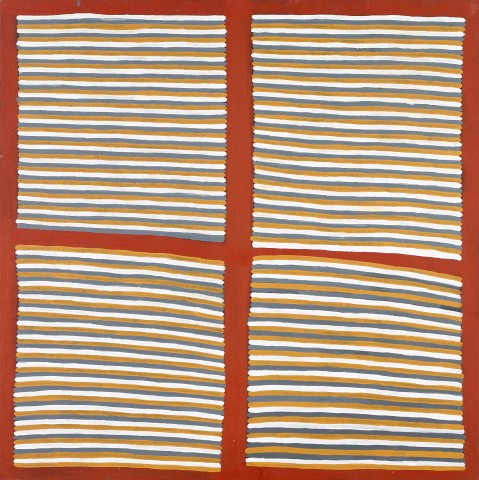WULMULLA, 1996
MICK NAMARARI TJAPALTJARRI
synthetic polymer paint on canvas
122.0 x 122.0 cm
bears inscription verso: artist’s name, size and Papunya Tula Artists cat. MN960853
Painted for Papunya Tula Artists in August 1996
Private collection, Melbourne
This work is accompanied by a certificate of authenticity from Papunya Tula Artists which states in part: 'This painting depicts designs associated with Walmulla, a swampy area close to Marnpi and south-east of the Kintore Community. A large number of Tingari Men gathered at this site to perform dances. While they were dancing, some of the men threw spears which the dancers dodged.
‘I paint real slow, no rush, just slow, big ones, little ones, just slow, every time’1
Described as a reserved man, Mick Namarari could also be characterised as an innovator whose impact on the Western Desert movement is only now starting to be fully understood. The breadth and scope of his ability, maintained with singular dedication over a painting career which spanned 27 years, is such that his work is considered to have ‘...transformed Papunya Tula art, heralding the ethereal minimalism of the late 1980s and 1990s… Up until he passed away in 1998, Mick Namarari was still quietly revolutionising the genre...’2
Born in sandhill country at Marnpi Rockhole, located south-west of the Mount Rennie Bore, Namarari and his sister were looked after by members of his extended family after the death of his father. He attended school at the Hermannsburg mission until he was eleven years old, and was initiated in the Areyonga region, eventually working in the cattle industry. He adopted the middle name ‘Namarari’ after his employer MacNamara - though it also expressed similarities to one of Namarari's totems, the mallee fowl.
Western Desert painting operates in the space between ceremony and country, referencing each whilst exploring ancestral inheritance. Mick Namarari's works are loaded with symbolism which is closely tied to traditional narratives in a densely and tightly coded abstraction. He developed a visual language which was influenced by cultural protocol, but never restrained by it. His innovation was a consequence of his continual need to paint and a refining of his imagery over time. Namarari was one of the first to experiment with fields of dotting devoid of figuration or traditional design motifs and in the early 1990s, together with Turkey Tolsen Tjupurrula, Namarari explored minimal representation. Utilising bold, undotted lines of colour and at the same time focusing on just one aspect of a story, this shift in direction would influence Papunya Tula painting from the late 1990s well into the 2000s.
Wulmulla 1996 was painted in the final years of Namarari’s life. The painting is a gracefully controlled rendition of an episode of the Tingari cycle that takes place close to his birthplace of Marnpi, his homeland and a subject he returned to more and more in his later paintings. Painted on a black ground and framed by broad bands of red ochre, alternating lines of yellow, white and grey/blue create a minimal repetitious template that symbolize an excerpt from the mythical journeys of the Tingari ancestral men and women.
A founding member of Papunya Tula Artists, Namarari also served on the Papunya Council. In 1991 he was awarded the National Aboriginal Art Award, a moment which heralded not only public attention for the Papunya Tula artists, but also confirmed the importance of his practice within the community. In 1994 Namarari won both the Alice prize and was the recipient of the Australia Council's emeritus award for Indigenous artists, the Red Ochre Award.
1 Mick Namarari in conversation with Wayne Eager at the Yuendumu Sports day 1992, quoted in O’Halloran, A.B., Mick Namarari Tjapaltjarri; The Master of Marnpi, Life Design Australia, Sydney 2018, p. 148
2 Perkins, H., and Fink, H., ‘Genesis and Genius: The Art of Papunya Tula Artists’ in One Sun, One Moon, Aboriginal Art in Australia, Art Gallery of New South Wales, Sydney, 2007, p. 184
CRISPIN GUTTERIDGE
